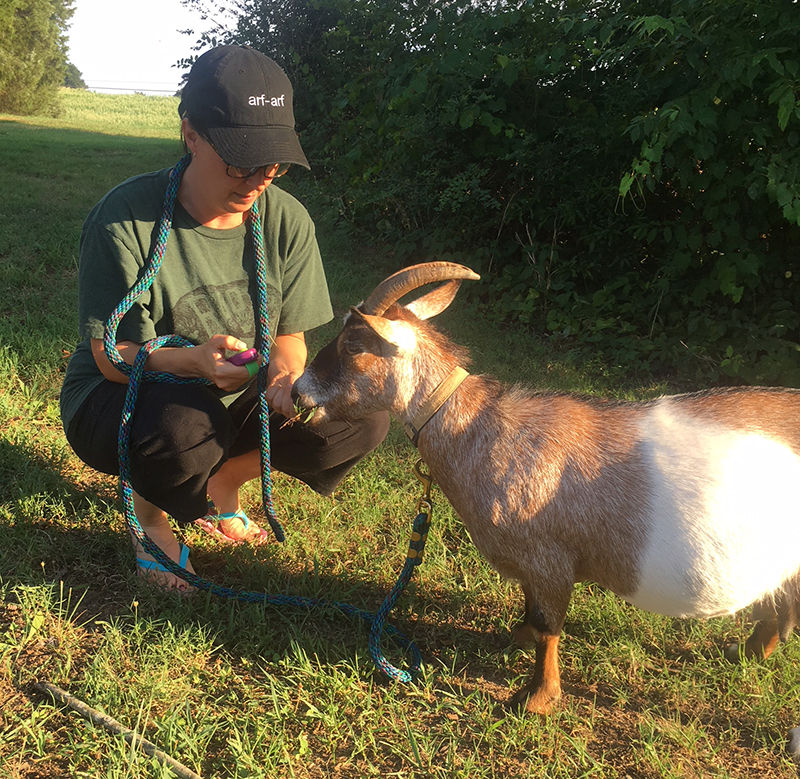
When I adopted my first dog, our puppy preschool class included clicker training. If you don’t know, clicker training is a form of classical conditioning: A matchbook-size device (available for a few dollars at any pet store) produces a clicking sound when a small lever is pushed. At first, the click is delivered with a treat. So, each time our dachshund, Molly, followed a command such as sit or stay, she earned a treat and a click. Over time, treats were phased out and the “click” became the reward.
Goats are often described as dog-like, so I wasn’t surprised to learn that clicker training is used on the curious caprines to encourage behaviors such as hopping onto a milking stand, pulling a cart or packing gear. Clicker training is also used to train goats for the show ring or just teach them fun tricks such as navigating an obstacle course. In the video below, a woman uses clicker training to get a goat to repeatedly return to a target on the grass.

It’s simple to do. You need a clicker and high-value treats to get started. (Our goats love raisins, sunflower seeds and apples.) Keep in mind that you’ll dole out a lot of treats during training, so offer only small nibbles, not handfuls, with each click.
Here are the steps to start clicker training:
Move to a Distraction-Free Zone

Our 12-week-old dwarf Nigerian, Willie Nelson, cannot focus when his herd is browsing a few feet away (and our other goats are too interested in the treats to give us space for effective training). We have a back pasture out of sight from the rest of the farm that works for training.
Start With Conditioning
The goat needs to learn that the “click” is a positive sound. Start by clicking the clicker and offering a treat. Repeat several times until he learns that a treat always follows the sound.
Integrate a Target
A target is a stick with a distinctive tip. You can make one from a dowel and a tennis ball; a feather duster would also work. The idea is to get the goat to focus on the tip of the target.

When the goat starts to associate the clicker with treats, up the ante. Hold the target close enough to the goat that he’ll touch it with his nose. (Given that goats are so curious, it won’t be difficult to get him to make contact). The moment his nose hits the target, even accidentally, click and reward with a treat. Repeat. The goat will come to associate the target with the reward.

Advance the Training
Now that the goat is interested in the target (and the treat that comes with touching it), make him work a little harder for the reward. Hold the target up high so he has to reach for it; walk around the pasture so he follows it. Each time, he touches the target, click and reward.
Once your goat recognizes the target and is eager to follow, start working on the desired behavior. If you need a doe to hop on a milking stand, hold the target over the stand; click and reward when she hops up. If the goal is to have a loose-leash pack goat, hold the target a few feet in front of his nose and have him follow it—without straining the leash—as you walk him around the pasture on a lead rope.
Keep Sessions Short
Your goat has a short attention span. After a few minutes of training, reintegrate the goat with the herd so he can go back to being a regular goofball, er, goat. You can have several (spaced out) training sessions each day to condition positive behaviors but keep each one super short.
Be Consistent
Training needs to be consistent to be successful. Offer a click and reward each time the goat performs the desired behavior. Your goat will recognize if the rewards are inconsistent, and his behavior could become inconsistent, too.
Phase Out Treats Over Time
As the goat becomes more comfortable with the clicker, offer treats every other time (but continue using the clicker each time the goat does what he’s asked). Slowly scale back on the treats but continue with the clicker. Over time, the click sound serves as the reward. Below is a video of a goat trainer at the Memphis Zoo who has taught her animals to do several moves with clicker training.

Clicker training is positive, reward-based training, so click only for desired behavior—and never punish a goat for not performing. If a doe doesn’t jump on the milking stand or a pack goat strains on his lead, that’s OK. Simply start again and reward the goat for getting it right. Clicker training should be a positive experience for you and your herd.




